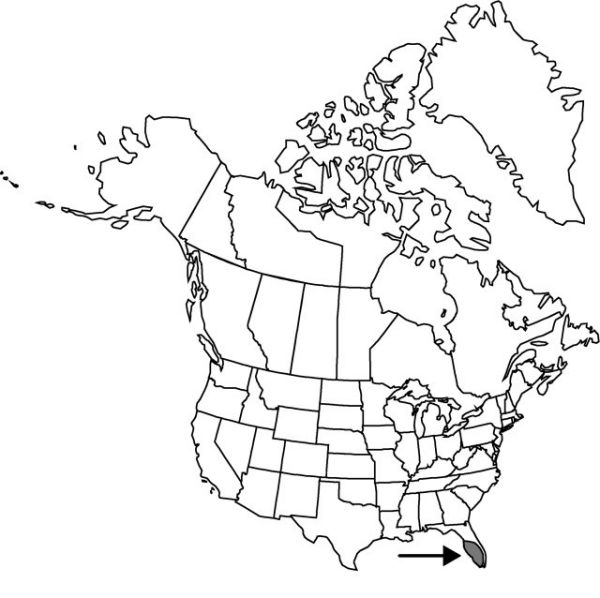Difference between revisions of "Harrisella porrecta"
J. Bot. 47: 266. 1909.
FNA>Volume Importer |
FNA>Volume Importer |
||
| Line 14: | Line 14: | ||
|name=Campylocentrum porrectum | |name=Campylocentrum porrectum | ||
|authority=(Reichenbach f.) Rolfe | |authority=(Reichenbach f.) Rolfe | ||
| − | }}{{Treatment/ID/Synonym | + | }} {{Treatment/ID/Synonym |
|name=Harrisella amesiana | |name=Harrisella amesiana | ||
|authority=Cogniaux | |authority=Cogniaux | ||
| − | }}{{Treatment/ID/Synonym | + | }} {{Treatment/ID/Synonym |
|name=Harrisella uniflora | |name=Harrisella uniflora | ||
|authority=H. Dietrich | |authority=H. Dietrich | ||
| Line 35: | Line 35: | ||
|elevation=0–20 m | |elevation=0–20 m | ||
|distribution=Fla.;Mexico;West Indies;Central America (El Salvador). | |distribution=Fla.;Mexico;West Indies;Central America (El Salvador). | ||
| − | |discussion=<p>Four species have been recognized in Harrisella: H. porrecta, H. filiformis (Swartz) Cogniaux, H. monteverdi (Reichenbach f.) Cogniaux, and H. uniflora Dietrich (H. Dietrich 1982). Harrisella porrecta is sometimes confused with H. filiformis (e.g., N. L. Britton et al. [1923–]1930, vol. [1], part 2); a comparison of the types clearly shows that they are distinct. Harrisella filiformis and H. monteverdi are synonymous and belong to the related genus Campylocentrum (J. D. Ackerman 1995). The Cuban H. uniflora appears to be a depauperate H. porrecta. Nonetheless, the genus may not be monotypic. Mexican populations of H. porrecta do have some distinctive features and may represent at least one additional species (N. M. Warford 1997).</p> | + | |discussion=<p>Four species have been recognized in <i>Harrisella</i>: <i>H. porrecta</i>, H. filiformis (Swartz) Cogniaux, H. monteverdi (Reichenbach f.) Cogniaux, and <i>H. uniflora</i> Dietrich (H. Dietrich 1982). <i>Harrisella porrecta</i> is sometimes confused with H. filiformis (e.g., N. L. Britton et al. [1923–]1930, vol. [1], part 2); a comparison of the types clearly shows that they are distinct. <i>Harrisella</i> filiformis and H. monteverdi are synonymous and belong to the related genus <i>Campylocentrum</i> (J. D. Ackerman 1995). The Cuban <i>H. uniflora</i> appears to be a depauperate <i>H. porrecta</i>. Nonetheless, the genus may not be monotypic. Mexican populations of <i>H. porrecta</i> do have some distinctive features and may represent at least one additional species (N. M. Warford 1997).</p> |
|tables= | |tables= | ||
|references= | |references= | ||
| Line 59: | Line 59: | ||
|publication year=1909 | |publication year=1909 | ||
|special status= | |special status= | ||
| − | |source xml=https://jpend@bitbucket.org/aafc-mbb/fna-data-curation.git/src/ | + | |source xml=https://jpend@bitbucket.org/aafc-mbb/fna-data-curation.git/src/8f726806613d60c220dc4493de13607dd3150896/coarse_grained_fna_xml/V26/V26_1271.xml |
|subfamily=Orchidaceae subfam. Epidendroideae | |subfamily=Orchidaceae subfam. Epidendroideae | ||
|tribe=Orchidaceae tribe Vandeae | |tribe=Orchidaceae tribe Vandeae | ||
Revision as of 16:41, 18 September 2019
Plants leafless, inconspicuous. Roots numerous, silvery gray-green, 0.25–1 mm diam., covering stems. Stems erect with a few reddish brown, scarious scales, to 15 mm. Inflorescences few to many, lax racemes or panicles arising through mass of roots, 2–5 cm; floral bracts less than 1 mm. Flowers pale yellow; dorsal sepal elliptic, obovate, 2–2.5 × 1.3 mm, apex obtuse to rounded; lateral sepals obliquely elliptic-ovate, 2–2.5 × 1–1.2 mm, apex obtuse to rounded; petals ovate, obtuse, clawed, slightly smaller than sepals; lip broadly ovate, concave, 2.7–4 mm, base with short, apically expanded, scrotiform spur 1 mm wide, margins involute, apex obtuse to rounded; disc with erect tubercle; column stout, 0.25 mm; ovary subsessile, 2 mm. Capsules reddish brown when mature, ovoid, 4.5–6 mm, sparsely verruculose.
Phenology: Flowering Aug–Sep.
Habitat: On twigs of shrubs and small trees, swamps, mesic hardwood hammocks
Elevation: 0–20 m
Distribution

Fla., Mexico, West Indies, Central America (El Salvador).
Discussion
Four species have been recognized in Harrisella: H. porrecta, H. filiformis (Swartz) Cogniaux, H. monteverdi (Reichenbach f.) Cogniaux, and H. uniflora Dietrich (H. Dietrich 1982). Harrisella porrecta is sometimes confused with H. filiformis (e.g., N. L. Britton et al. [1923–]1930, vol. [1], part 2); a comparison of the types clearly shows that they are distinct. Harrisella filiformis and H. monteverdi are synonymous and belong to the related genus Campylocentrum (J. D. Ackerman 1995). The Cuban H. uniflora appears to be a depauperate H. porrecta. Nonetheless, the genus may not be monotypic. Mexican populations of H. porrecta do have some distinctive features and may represent at least one additional species (N. M. Warford 1997).
Selected References
None.
